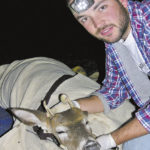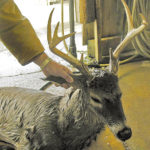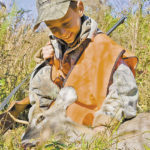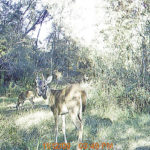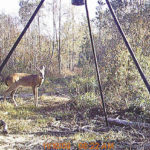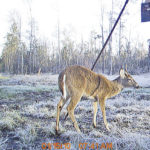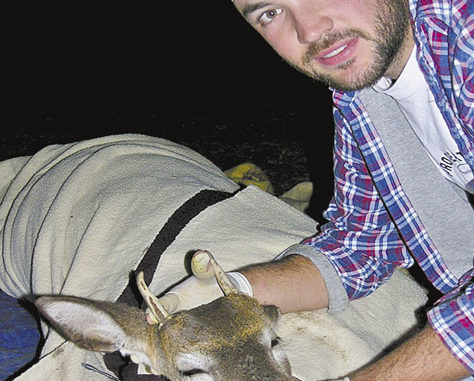
Should you shoot that big cowhorn that just walked into your food plot, or will you be stuffing your future into your freezer?
I’m not interested in growing giant, trophy bucks because — everybody repeat in unison — you can’t eat horns. However, I am interested in having a healthy population of deer on my meager Washington Parish property.
That’s why I’m interested in spikes. I’ve got so many I don’t know what to do with them.
Should I shoot them? Should I let them walk? Should I shoot some and leave others? Is there something wrong with my land? My deer?
Heck if I know. That’s why I spend more time looking up spike research on the Internet than I do my fantasy football stats.
One study recommended shooting spikes to keep their inferior genetics from getting passed down to future generations. Another study recommended never shooting a spike as it shot down the old adage about ‘once a spike, always a spike’ with pictures of yearling spikes that turned into 8-point 2 1/2-year-old bucks.
To make matters worse, I have a habit of listening to all the local-yokel advice that is freely distributed at work, after church and in the Academy hunting department.
One fellow actually told me that if two spikes were to come out, he would shoot the smallest one first and hope he could chamber another round before the bigger one ran away. That’s how badly he wanted them off his property.
However, the studies I found on the Internet were all from other states. The local advice, while well-meaning, was based more on individual biases and prejudices than sound scientific findings. I decided to call the voice of reason when it comes to Louisiana’s deer population. Hopefully he could shed some light on my situation.
“You can shoot down the adage about ‘once a spike, always a spike,’” said Louisiana Deer Study Leader Scott Durham. “That’s not true. Spikes can end up being really good deer later on. However, individual deer are just like individual people, and that’s the rub.”
No don’t get me wrong. I’ll shoot a spike just a quickly as any other deer if I need some sausage in the freezer. However, spikes are just about all I see except for does when I go hunting. Is it wrong for me to want to at least see some nicer deer? I’ll even settle for seeing them on my camera. At least I’ll know they’re here.
“Forget about spikes for a moment,” Durham said. “Some Mississippi studies have shown that lower-scoring deer are likely to be, on average, lower-scoring older deer. Higher-scoring younger deer are, on average, likely to be higher-scoring older deer. That’s kind of comparing means among age classes, though. There’s no way to tell what they’re going to eventually be when you’re looking at a year-and-a-half-old deer.”
Lots of researchers believe it is best to look at a deer at 2 1/2 years old to determine its genetic potential. As a result, many quality deer management types advocate passing all the yearlings no matter their antlers.
“I don’t really prescribe to that personally,” Durham said. “It’s OK to harvest some yearling deer because I think, overall in deer management programs, you need to harvest x number of bucks. You don’t want to shoot them in the same proportion as does, but bucks eat groceries, too.”
Here’s the problem, though. All spikes are not created equally. There is a big difference between robust 120-pound spikes with good mass and 6-inch spikes and 80-pound pencil spikes that are less than 3 inches long. The small one could have been born late. It could have been orphaned really early as a fawn.
“All spikes are not equal even among an age class,” Durham said. “We do have a lot of late breeding, especially in Areas 1 and 6, and deer born later don’t have the same ability to develop. They don’t start making antlers until their skeletal and muscle growth are first satisfied. Late-born deer don’t put on antler growth like a young early born deer.”
Durham says this comparison has to be made within the same region even in the late-breeding areas because deer born at the beginning of a particular region’s birthing period are going to have a better start than those born later.
Although it’s fair to say that an earlier-born yearling spike has a better chance of becoming a better 2 1/2-year-old deer, Durham says there are so many variables in nature that it’s impossible to judge even the later-born smaller yearling spikes in terms of into what kind of bucks they will eventually develop.
So how long does a landowner like me have to wait for all of his spikes to turn into something better? According to a recent telemetry study conducted in West Baton Rouge Parish, not long at all.
“I don’t like to use a sample size of only three or four bucks,” Durham said, “but during this recent study that we just finished, we collared a 1 1/2-year-old spike that turned into a really fine 8-point the very next year. Of course, that’s just one deer, so it’s not something that I published, but it shows maybe a good, well-developed cowhorn could absolutely be a good 2 1/2-year-old buck.”
However, there is very little chance of a little 80-pound, 1-inch spike developing like that within one year. A spike like this might be a 2-year-old spike, but it could be a little 4-point or a little basket 6.
The point is that better spikes are more likely to turn into quality deer than those that were stunted for whatever reason. But at 4 1/2 or older, that smaller spike might have caught up to the rest of the herd.
Whether fawns turn out to be yearling spikes or something better is also determined by soil regions. Low-productivity soils like that found in about half of Louisiana plays a big role in antler development. Durham illustrated this variable by pointing out our own diets.
“If you’re in a poor-soil region, it’s like setting the table with nothing but soup versus a guy that can sit down and eat a fine, balanced meal,” he said. “The guy who can sit down and eat a variety of things over the course of time is going to turn out to be a healthier individual as opposed to the guy who eats the same thing over and over again.”
The “soup” regions in Louisiana are the rice prairies, coastal marshes, the long-leaf pine areas and the flat woods found in lower St. Tammany and a little bit of Washington parishes. Deer in the poor regions won’t have nearly the antler development as deer in the better-soil areas like the bottomland hardwoods found along the Mississippi River.
While shooting spikes boils down to a personal decision based on your own management plan, Durham pointed out that there are some instances in which hunters would want to shoot a spike even if their plan was to let them grow.
“Sometimes we get some older spikes,” he said “Those deer, I would harvest. Older spikes are not rare in Louisiana — every place may have a couple — but they’re not super common either. By the time a deer is 2 1/2 years old, he should have some branched antlers. Deciding to shoot an older spike is based on a hunter’s ability to age on the hoof, which is difficult to do accurately.”
Although aging deer on the hoof is difficult, it’s not that hard to determine whether you’re looking at a yearling spike. These 1 1/2-year-old deer tend to be more athletic and nimble-looking and kind of lean and smallish. On the other hand, a 2 1/2-year-old deer is thicker, more muscular and robust looking.
“A 2 1/2-year-old spike maybe has something going on,” Durham said. “Again, deer generally exhibit their genetic potential by the time they’re this age, so you would probably want to take him out of your herd if you’re interested in growing racks.”
If you are interested in having better quality deer on your property, Durham says the best thing you can do is manage it to keep your deer population at or below its carrying capacity, which can vary wildly across Louisiana. This can be achieved by managing your native habitat and shooting bucks and does according to your management plan.
Over time, this will result in a healthier deer population that could possibly produce fewer spikes simply because young fawns aren’t getting pushed aside from the competition. Also, the does will be healthier and produce more nutritious milk, which makes up a fawn’s primary nutrient load for the first three months of life.
“A spike, even a little spike, could end up being a great deer at 5 or 6 years old,” Durham said. “The belief is they eventually catch up, but my belief is that you need to crop off deer based on your habitat, and it’s not a sin to take a spike, even a small spike, to reduce your buck component if necessary. In that case, you might be better off to pass a better 2- or 3-year-old deer than a spike.”
I heard on a hunting show recently that for the public to accept hunting in the future, deer hunters have to transition to becoming deer managers. That means each of us has to decide how to manage our own property based on our individual goals and our own definitions of the word “quality.”
My goal right now is to attract and hold a few more deer on my property and to allow the antlers to get a little bigger. As a result, I’ve elected to pass on my spikes this year in hopes of some of them making that magical one-year transformation.
On the other hand, my son has decided that quality means grilled Bambi bites. And he’s put me on notice that any spike that comes out on him should be considered a dead deer walking. You never know unless you let them grow, but you can’t grill them unless you kill them.
